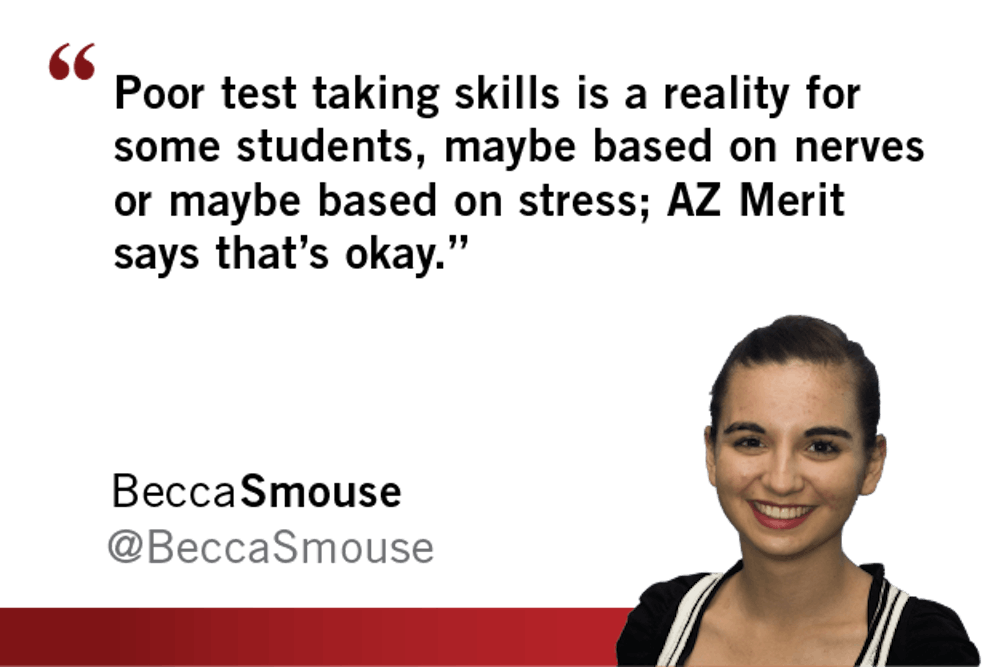Education in Arizona has taken a giant step forward by accepting a new testing system that does not label students as a test score but instead measures student retention of information from classroom.
The Arizona State Board of Education adopted Arizona’s Measurement of Education Readiness to Inform Teaching, known as AZ Merit, this November. The test is designed to measure student understanding in subjects like math and English.
Beginning in spring 2015, the test will be administered to almost all students in primary education, starting with third graders up through high school.
 AZ Merit was designed to replaced Arizona’s flawed standardized testing system known as Arizona’s Instrument to Measure Standards, or AIMS.
AZ Merit was designed to replaced Arizona’s flawed standardized testing system known as Arizona’s Instrument to Measure Standards, or AIMS.
To the blind eye, it might seem like Arizona is just swapping one standardized test out for another. But those who are a product of AIMS testing know first hand the stressful test did not measure knowledge, but rather tested ability to memorize a handful unrelated definitions and equations.
Teachers were notorious for “teaching to the test," seemingly dropping their own curricula to make sure their students knew which bubbles to fill on an ambiguous question about grammar from unconvincing passages.
AZ Merit is designed to change the classroom environment entirely.
“A key phrase is 'inform teaching.' Tests are supposed to be tools. Ideally, they show what students learned and what's still lacking,” The Arizona Republic’s Editorial Board wrote.
Standardized testing will not longer seem like a threat to the classroom, but rather an asset for teachers to measure their students’ progress. Teachers will have their freedom back to instruct in a way that best suits their individual, unique class of students.
The test is no longer coated with gold — a fail does not terminate the opportunity to graduate. Poor test-taking skills is a reality for some students, maybe based on nerves or maybe based on stress; AZ Merit says that’s OK.
“But the big difference is that students can fail that test without it affecting their ability to graduate,” The East Valley Tribune reported.
We can now encourage our students to take the test results for full value, instead of passing just to graduate. By alleviating that pressure, we can properly use test results to hone in on areas that might need improvement for our own personal gain, not just to fill in the right bubbles.
We are not labeling our graduates by a system of a-b-c’s and fill-in-the-blanks. We are defining them by their work in the classroom.
“Unlike AIMS, this is not a graduation test. It is not meant to penalize. It's meant to guide teaching,” The Republic said.
Conversations about the classroom are changing for Arizona. We are moving toward a comprehensive system that encourages growth, rather than demanding perfection. The standards commonly known as Common Core are making their way through districts, influencing teachers to prepare students for the future.
However, we took a step backward by electing Diane Douglas as Superintendent of Public Instruction. She ran on a platform to eliminate Common Core from the discussion, but Arizona is incorporating aspects of the program. Douglas has little to no power to stop the momentum.
Arizona education is moving forward, and the public is whole-heartedly behind it. Some are already asking to have Douglas recalled.
AZ Merit is included in that movement forward. The test will hopefully encourage students to learn from their mistakes and allow teachers to instruct free of the chains of a desired test score.
Reach the columnist at rsmouse@asu.edu or follow her on Twitter @BeccaSmouse
Editor’s note: The opinions presented in this column are the author’s and do not imply any endorsement from The State Press or its editors.
Want to join the conversation? Send an email to opiniondesk.statepress@gmail.com. Keep letters under 300 words and be sure to include your university affiliation. Anonymity will not be granted.
Like The State Press on Facebook and follow @statepress on Twitter.




